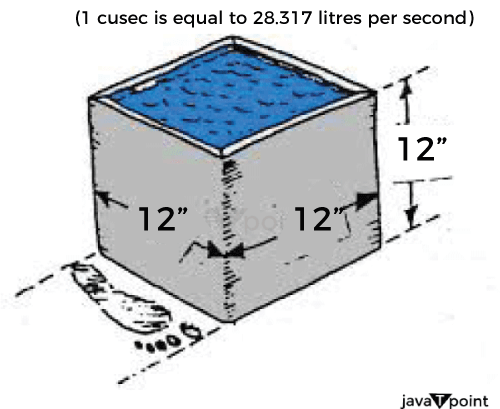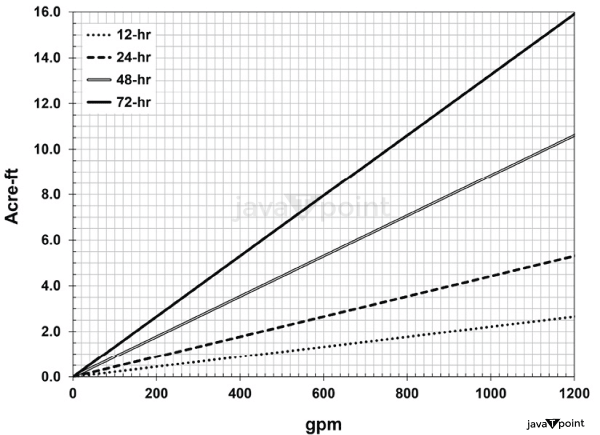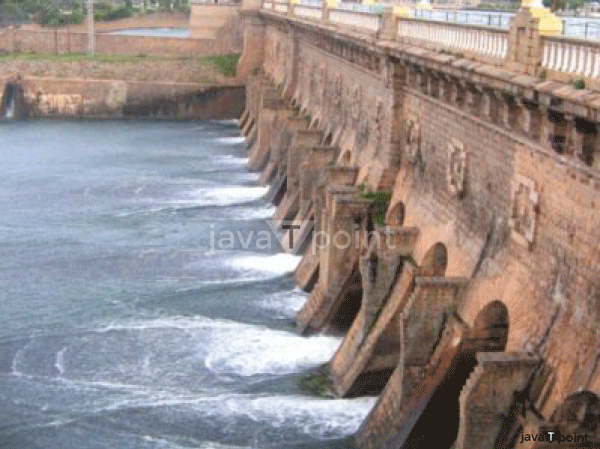1 Cusec is Equal to How Many Litres?Understanding and managing water resources requires measuring water flow rates in several disciplines, including hydrology, engineering, and fluid dynamics. "Cusec," which stands for cubic feet per second, is one often used unit for calculating flow rate. The liter, frequently used to measure liquid volumes in many nations, is another widely recognized volumetric measurement unit. Understanding the conversion between Cusec and liters is crucial for precise flow rate calculations and efficient communication between locations and specialties. In this post, we shall examine the link between Cusec and liters and offer details on the conversion factor and its usefulness. 
Explanation for Cusec (Cubic Foot per Second)The measuring unit cusec, or cubic foot per second, expresses the rate at which water or other fluids move. The United States and other nations that use the imperial system of units are where it is most prevalent. The volume of a cube with one-foot-long sides is called a "cubic foot". The foundation of the cusec concept is how much fluid-typically water-passes through a certain spot in a specified amount of time. It symbolizes the amount of water that moves by a specific location in a second. Consider a pipe with a one-square-foot cross-section to understand the Cusec. If the water flow rate via this pipe is one cubic foot per second, then one cubic foot of water goes through the pipe every second. River, stream, canal, and other water body flow rates are frequently measured in Cusec. It aids in calculating the quantity of water available for use in agriculture, hydropower production, and water delivery systems, among other things. Remembering that Cusec is not a standard measurement unit globally is vital. The cubic meter per second (m3/s) is the typical unit used to measure flow rate in the metric system. However, conversions to more widely accepted units like liters are still required because Cusec is still widely used in some areas and sectors. The following parts will discuss the conversion factor between Cusec and liters. Doing so can fill the gap between these two units and make correct flow rate calculations possible for various measurement systems. Definition and Explanation of LitresA frequent volume unit in the metric system is the liter. The letter "L" or "l" is used to represent it; the lowercase letter "L" is chosen to prevent confusion with the number one. The cubic meter (m3), a bigger measure serving as the standard volume unit in the International System of Units (SI), is a subunit of the liter. One cubic decimeter (dm3) of space occupies one liter of space. In other words, a cube with sides that are 10 cm long will have a volume of one liter. The volume that 1,000 cubic centimeters (cm3) or 0.001 cubic meters (m3) occupy is another way to conceive of it. A liter is a common unit of measurement for liquid volumes in daily life. It is used for liquid home products, alcoholic beverages, and fuel. For instance, when you buy a 1-liter bottle of water, you purchase a 1-liter container. The liter is frequently combined with the metric system for accurate volume measurements in scientific and technical domains. For calculations and conversions, it offers a practical and simple unit. The following connections are useful for converting between liters and other metric volume units:
When working with fluid measurements and conversions, understanding the liter as a unit of volume is crucial since it enables consistency and accuracy in various scientific, industrial, and commonplace applications. Conversion Factors for Cusec to LitresThe flow rate must be changed from one unit to another to convert between Cusec (cubic foot per second) and liters. We must consider the link between cubic feet and liters and the passage of time to perform this conversion. The volume of 1 cubic foot (ft3) is equivalent to roughly 28.3168466 liters (L). We must multiply the flow rate in Cusec by the conversion factor of 28.3168466 to convert Cusec to liters per second (L/s). The resulting value will indicate the corresponding flow rate in liters per second. 
For instance, the conversion to liters per second at a flow rate of 2 cusecs would be: 2 cusec * 28.3168466 L/s per cusec = 56.6336932 L/s Thus, a flow rate of 2 cusecs equals roughly 56.63 liters per second. It's crucial to remember that the supplied conversion factor is only a rough estimate, and using more precise figures or considering your application's particular requirements for precise computations is recommended. Calculation ProcessYou can use the following calculator to convert a flow rate from cubic feet per second (Cusec) to liters per second (L/s):
Let's use an example to demonstrate the computation process: For instance, convert 3.5 cusecs of flow rate to liters per second.
The flow rate is 3.5 * 28.3168466 liters per second (L/s). L/s flow rate = 99.1249131 As a result, 3.5 cusec of flow is comparable to 99.12 liters per second. Keep in mind that the conversion factor offered is only a rough estimate. Consider more precise figures or particular requirements depending on your application for more accurate calculations. Conversion Example for Cusec to LitersLet's execute a cusec (cubic foot per second) to liters conversion. Approximately 28.3168466 liters per Cusec will be used as the conversion factor. ExampleConvert 1.75 cusec of flow rate to liters. The flow rate is equal to 1.75 cusecs. Factor of conversion = 28.3168466 We multiply the flow rate in Cusec by the conversion factor to convert Cusec to liters. 1.75 cusec * 28.3168466 liters per Cusec is the flow rate in liters. Flow rate is 49.552481 liters per second A flow rate of 1.75 cusecs hence roughly equates to 49.55 liters. Remember that this is merely an illustration and that the real conversion factors or precision demands may change depending on the situation or application. Uses and Importance of Conversion from Cusec to LitersIt is crucial and useful to convert Cusec (cubic feet per second) to liters in various contexts. The following are some crucial contexts where the Cusec to liters conversion matters: 1. Water Resource Management 
Accurate measurement and management of water resources are made possible by converting flow rates from Cusec to liters. It makes it possible to accurately calculate how much water is available, used, and distributed in rivers, streams, canals, and reservoirs. Planning irrigation systems, creating hydroelectric power, and managing water resources sustainably all depend on this information. 2. Engineering and Construction Numerous engineering tasks, like developing water supply systems, drainage systems, and wastewater treatment facilities, involve fluid flow calculations. When working with design specifications, equipment size, and hydraulic calculations, conversion of flow rates from Cusec to liters guarantees consistency and compatibility. 3. Environmental Monitoring Quantifying water flow through ecosystems in environmental studies and research requires translating flow rates from Cusec to liters. It assists in analyzing streams' health, monitoring pollution spread, and determining how human activities affect water systems. 4. International Cooperation The countries that utilize the Imperial measurement system are where the cusec unit is most commonly used. However, translating flow rates to liters per second in international contexts or when working with nations that employ the metric system promotes effective communication, data interchange, and uniformity of units for flow measurements. 5. Cross-Disciplinary Communication Flow rates can be expressed using a variety of units depending on the discipline, including hydrology, civil engineering, environmental science, and agriculture. Professionals from various fields may accurately comprehend and analyze flow rate data thanks to converting Cusec to liters, encouraging cross-disciplinary cooperation and knowledge sharing. 6. Educational and Research Purposes Conversions between different units are frequently used for teaching and learning about flow rates for educational and research purposes. By introducing students and researchers to unit conversions, dimensional analysis, and the real-world usage of flow rate measurements, the cusec to liters conversion adds value to education. Consistent data analysis, reporting, and decision-making depend on accurate translation between Cusec and liters. It ensures efficient information interchange, reduces computation mistakes, and promotes efficient use and management of water resources. Constraints and Differences in ConversionWhile converting between Cusec (cubic foot per second) and liters offers a practical way to compare flow rates, it's vital to be aware of several restrictions and potential differences. Here are some crucial things to remember: 1. Approximate Conversion Factor Approximately 28.3168466 is frequently used to convert from cubic seconds to liters. Remember that this is only an estimate and could change based on the situation or location. Using more specific conversion factors for computations or referring to the relevant standards and references is recommended. 2. Varied Definitions Depending on the geography or industry, the cusec unit may have slightly varied definitions or interpretations. This fluctuation may impact the precision of the conversion. It is crucial to confirm that the cusec definition being utilized corresponds to the liter conversion factor that is meant to be used. 3. Consistency of Time Units The conversion from cubic seconds to liters assumes that the flow rate is given in seconds. But it's crucial to ensure that every calculation and measurement uses the same time unit for the conversion. Results can be accurate when time units are matched. 4. Local Customs Depending on the area or topic of study, there may be regional customs or preferred units for measuring flow rates. These conventions might not match the conversion of Cusec to liters. For proper communication and data analysis, it is crucial to be aware of such discrepancies and ensure appropriate conversions are used. 5. Errors in Unit Conversion When calculating the conversion, rounding mistakes or incorrect conversion factors can happen. These inaccuracies may impact the outcome, particularly when working with big data sets or exact computations. It is essential to utilize the most specific conversion factors available and keep the computations at the appropriate degree of precision. 6. Context-Specific Considerations When executing the conversion, it is crucial to consider the application's particular context and requirements. To achieve correct conversions between Cusec and liters, several parameters may need to be considered, including variations in temperature, pressure, fluid characteristics, or particular measuring procedures. Users can choose wisely when converting flow rates between Cusec and liters by being aware of these restrictions and fluctuations. To achieve suitable and meaningful conversions, it is essential to consider the particular context, available data, and required level of accuracy. Other Units for Measuring Flow RateIn addition to Cusec and liters, other units measure flow rates. Here are a few frequently used units across many measurement systems: 1. Cubic Meter per Second (m³/s) In the International System of Units (SI), the cubic meter per second is the default flow rate unit. It illustrates the amount of fluid that flows through a location in a second. 2. Gallon per Minute (gpm) The gallon per minute (gpm) unit of measurement, widely used in the United States, calculates the flow rate of liquids in gallons per minute. It is frequently employed to gauge water flow in irrigation and plumbing systems found in homes. 3. Cubic Feet per Minute (cfm) This measurement unit for the air flow rate is frequently used in ventilation and engineering systems. It serves as a representation of the airflow rate. 4. Liters per Hour (L/h) This measurement represents the amount of liquid flowing each hour in liters. It is frequently employed in situations requiring the measurement or specification of slower flow rates, such as in some medical devices or small-scale chemical reactions. 5. Barrel per Day(bpd) The oil and gas industry uses the barrel per day (bpd) as a primary unit of measurement for the flow rate of petroleum and its byproducts. It shows how many barrels of crude oil or other liquid petroleum products are produced or moved daily. 6. Cubic Inch per Second (in³/s) In engineering applications involving smaller quantities, such as hydraulic systems or fuel injectors, the cubic inch per second (in3/s) unit is frequently used to measure the flow rate in cubic inches per second. 7. Cubic Centimeter per Minute (cm³/min) This measuring unit measures flow rate in cubic centimeters per minute and is frequently used in chemical processes, medical equipment, and laboratory studies that call for accurate measurements at lower flow rates. Only a few units can be used to measure flow rates. The particular application, regional customs, and measurement system being employed all influence the choice of unit. To achieve accurate and insightful flow rate calculations and comparisons, knowing various units and how they are converted is crucial. ConclusionIn conclusion, accurate flow rate measurements and good communication across various measuring systems depend on understanding the conversion between Cusec (cubic foot per second) and liters. We can bridge the gap between these two units and convert flow rates from Cusec to liters using a conversion factor of roughly 28.3168466. Numerous sectors use the Cusec to liter conversion, including water resource management, engineering, environmental monitoring, global collaboration, and inter-disciplinary communication. It makes it possible to calculate water flow rates precisely, analyze data, and make decisions. Nevertheless, it's crucial to recognize that there are restrictions and potential differences when converting data. To ensure correct conversions, it is important to consider variables such as varied cusec definitions, fluctuating conversion factors, consistency of time units, regional customs, unit conversion errors, and context-specific concerns.
Next TopicConvert 10000 Paise to Rupees
|
 For Videos Join Our Youtube Channel: Join Now
For Videos Join Our Youtube Channel: Join Now
Feedback
- Send your Feedback to [email protected]
Help Others, Please Share










